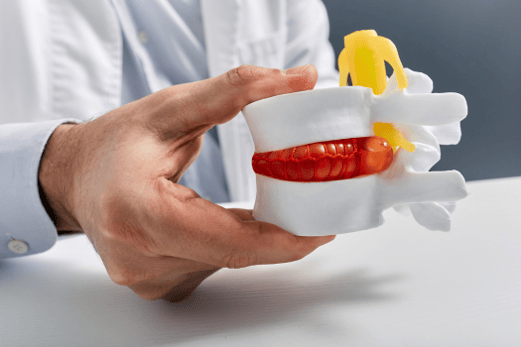
Lumbar disc herniation is a common condition that affects the lower back and can cause pain, numbness, or weakness in the legs. It occurs when the soft inner material of a disc bulges out through a tear in the outer layer and compresses a nerve root.
Some people with lumbar disc herniation may require lumbar discectomy surgery to remove the herniated disc material and relieve the pressure on the nerve. However, surgery may not always prove to be a permanent solution. There is a risk of reherniation, which means the disc material bulges out again at the same or a different level.
This article will discuss the rate of lumbar disc reherniation, the factors that may increase or decrease this risk, and the possible treatments for reherniated discs.
How Common Is Lumbar Disc Reherniation?
The rate of lumbar disc reherniation can vary depending on several factors, including the type of surgery, the skill of the surgeon, and the patient’s adherence to postoperative care instructions. Research suggests the recurrence rate ranges from 5 to 15 percent after lumbar discectomy surgery.What Factors Affect the Risk of Lumbar Disc Reherniation?
Several factors may influence the risk of lumbar disc reherniation, such as:- Age – Younger patients (under 40 years old) have a higher risk of reherniation than older patients (over 40 years old). This may be because younger patients have more elastic discs that are more prone to rupture and re-rupture.
- Smoking – Smoking is associated with a higher risk of reherniation than non-smoking. This may be because smoking impairs the blood supply and healing of the discs and increases inflammation and degeneration.
- Obesity – Obesity is linked to a higher risk of reherniation than normal weight. This may be because obesity increases the mechanical load and stress on the discs and weakens the supporting muscles and ligaments.
- Activity level – High physical activity or heavy lifting after surgery may increase the risk of reherniation, while moderate activity or exercise may decrease it. This may be because excessive activity can cause trauma or strain to the discs, while moderate activity can increase blood circulation and muscle strength.
- Surgical technique – The amount and location of disc material removed during surgery may affect the risk of reherniation. Removing too much or too little disc material may compromise the stability and integrity of the disc and increase the chance of recurrence. Removing disc material from the center or posterior part of the disc may also increase the risk of reherniation compared to removing it from the lateral or anterior part.
How Is Lumbar Disc Reherniation Treated?
The treatment options for lumbar disc reherniation depend on the severity of symptoms, the duration of recurrence, and the patient’s preference. Some possible treatments are:- Conservative treatment – This includes medication, physical therapy, epidural steroid injections, and lifestyle modifications. Conservative treatment may be effective for mild to moderate symptoms that last less than 6 months.
- Repeat discectomy – This involves removing the reherniated disc material through another surgery. Repeat discectomy may be indicated for severe or persistent symptoms that do not respond to conservative treatment or for patients who prefer surgery. However, repeat discectomy has a lower success rate and a higher complication rate than primary discectomy.
- Fusion surgery – This involves fusing two or more vertebrae together with screws, rods, cages, or bone grafts to prevent further movement and reherniation of the disc. Spinal fusion surgery may be considered for patients who have recurrent reherniations, instability, or degeneration of the disc or spine. However, fusion surgery is more invasive and complex than discectomy and may have higher risks and costs.
How Can Lumbar Disc Reherniation Be Prevented?
- Lumbar disc reherniation can often be prevented by following some recommendations, such as:
- Follow your doctor’s advice – Take your prescribed medications as directed and follow up with your doctor regularly. If your doctor recommends physical therapy or other treatments, stick to the plan and do not skip sessions.
- Rest when needed – Avoid activities that worsen your pain or cause more pressure on your spine. Rest when you feel tired or sore, but do not stay in bed for too long, as this can lead to stiffness and muscle weakness.
Stay active as much as possible – Engage in low-impact exercises that strengthen your core muscles and improve your flexibility and posture. Examples include walking, swimming, cycling, yoga, or Pilates. Avoid high-impact exercises that involve twisting, bending, or lifting heavy objects. - Maintain a healthy weight – Excess weight can put more stress on your spine and discs and slow down your healing process. Eat a balanced diet that includes plenty of fruits, vegetables, whole grains, lean protein, and healthy fats. Avoid processed foods that are high in sugar, salt, or fat.
- Quit smoking – Smoking can impair blood circulation and delay tissue healing. It can also increase inflammation and weaken your bones and discs. Quitting smoking can boost your overall health and speed up your recovery.
Even though discectomy surgery is a common and generally quite successful procedure, a hole is frequently left in the outer wall of the disc. In fact, patients with these large holes in their discs are more than twice as likely to reherniate. Reherniations often require additional surgery, which may include spinal fusion surgery. Fortunately, there is a new treatment specifically designed to close the large holes that are often left in spinal discs after discectomy surgery. Barricaid is a bone-anchored device proven to reduce reherniations, and 95 percent of Barricaid patients did not undergo a reoperation due to reherniation in a 2-year study timeframe. This treatment is done immediately following the discectomy—during the same operation—and does not require any additional incisions or time in the hospital.
If you have any questions about the Barricaid treatment or how to get access to Barricaid, ask your doctor or contact us at 844-705-1081.
For full benefit/risk information, please visit: https://www.barricaid.com/instructions.


Comments